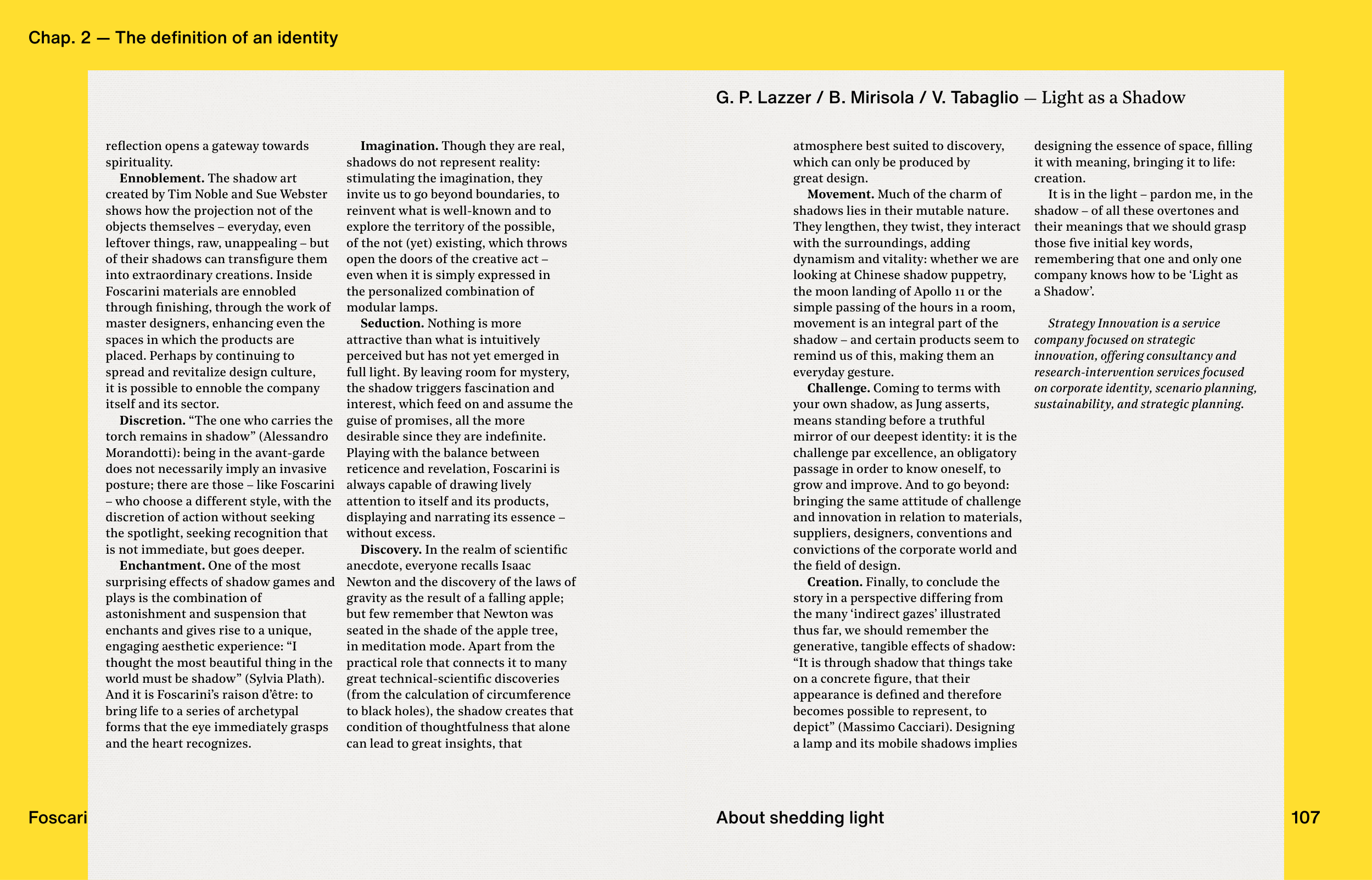107
Foscarini
Chap. 2 — The defi nition of an identity
refl ection opens a gateway towards
spirituality.
Ennoblement. The shadow art
created by Tim Noble and Sue Webster
shows how the projection not of the
objects themselves – everyday, even
leftover things, raw, unappealing – but
of their shadows can transfi gure them
into extraordinary creations. Inside
Foscarini materials are ennobled
through fi nishing, through the work of
master designers, enhancing even the
spaces in which the products are
placed. Perhaps by continuing to
spread and revitalize design culture,
it is possible to ennoble the company
itself and its sector.
Discretion. “The one who carries the
torch remains in shadow” (Alessandro
Morandotti): being in the avant-garde
does not necessarily imply an invasive
posture; there are those – like Foscarini
– who choose a different style, with the
discretion of action without seeking
the spotlight, seeking recognition that
is not immediate, but goes deeper.
Enchantment. One of the most
surprising effects of shadow games and
plays is the combination of
astonishment and suspension that
enchants and gives rise to a unique,
engaging aesthetic experience: “I
thought the most beautiful thing in the
world must be shadow” (Sylvia Plath).
And it is Foscarini’s raison d’être: to
bring life to a series of archetypal
forms that the eye immediately grasps
and the heart recognizes.
Imagination. Though they are real,
shadows do not represent reality:
stimulating the imagination, they
invite us to go beyond boundaries, to
reinvent what is well-known and to
explore the territory of the possible,
of the not (yet) existing, which throws
open the doors of the creative act –
even when it is simply expressed in
the personalized combination of
modular lamps.
Seduction. Nothing is more
attractive than what is intuitively
perceived but has not yet emerged in
full light. By leaving room for mystery,
the shadow triggers fascination and
interest, which feed on and assume the
guise of promises, all the more
desirable since they are indefi nite.
Playing with the balance between
reticence and revelation, Foscarini is
always capable of drawing lively
attention to itself and its products,
displaying and narrating its essence –
without excess.
Discovery. In the realm of scientifi c
anecdote, everyone recalls Isaac
Newton and the discovery of the laws of
gravity as the result of a falling apple;
but few remember that Newton was
seated in the shade of the apple tree,
in meditation mode. Apart from the
practical role that connects it to many
great technical-scientifi c discoveries
(from the calculation of circumference
to black holes), the shadow creates that
condition of thoughtfulness that alone
can lead to great insights, that
About shedding light
atmosphere best suited to discovery,
which can only be produced by
great design.
Movement. Much of the charm of
shadows lies in their mutable nature.
They lengthen, they twist, they interact
with the surroundings, adding
dynamism and vitality: whether we are
looking at Chinese shadow puppetry,
the moon landing of Apollo 11 or the
simple passing of the hours in a room,
movement is an integral part of the
shadow – and certain products seem to
remind us of this, making them an
everyday gesture.
Challenge. Coming to terms with
your own shadow, as Jung asserts,
means standing before a truthful
mirror of our deepest identity: it is the
challenge par excellence, an obligatory
passage in order to know oneself, to
grow and improve. And to go beyond:
bringing the same attitude of challenge
and innovation in relation to materials,
suppliers, designers, conventions and
convictions of the corporate world and
the fi eld of design.
Creation. Finally, to conclude the
story in a perspective differing from
the many ‘indirect gazes’ illustrated
thus far, we should remember the
generative, tangible effects of shadow:
“It is through shadow that things take
on a concrete fi gure, that their
appearance is defi ned and therefore
becomes possible to represent, to
depict” (Massimo Cacciari). Designing
a lamp and its mobile shadows implies
designing the essence of space, fi lling
it with meaning, bringing it to life:
creation.
It is in the light – pardon me, in the
shadow – of all these overtones and
their meanings that we should grasp
those fi ve initial key words,
remembering that one and only one
company knows how to be ‘Light as
a Shadow’.
Strategy Innovation is a service
company focused on strategic
innovation, offering consultancy and
research-intervention services focused
on corporate identity, scenario planning,
sustainability, and strategic planning.
G. P. Lazzer / B. Mirisola / V. Tabaglio — Light as a Shadow
107


